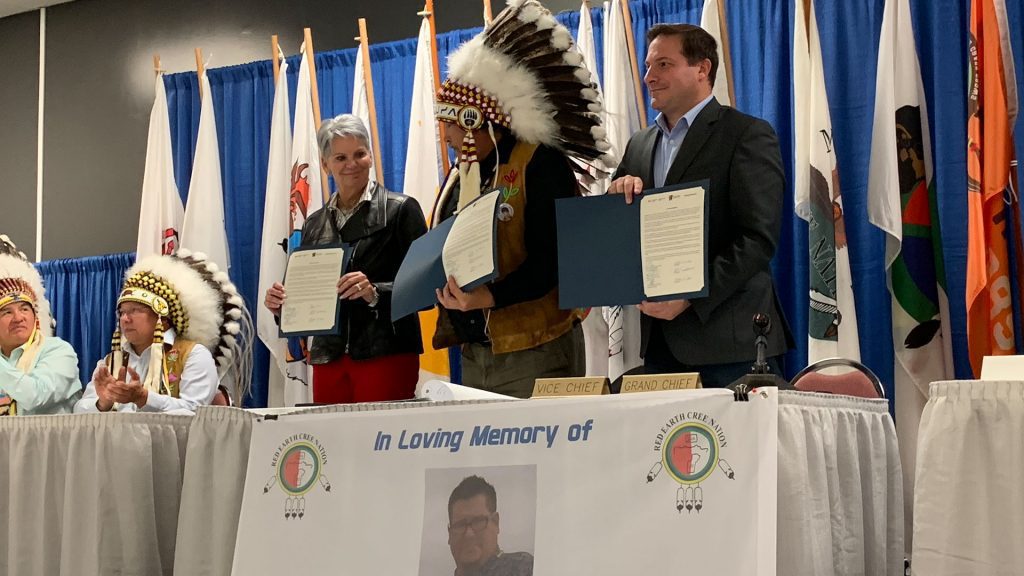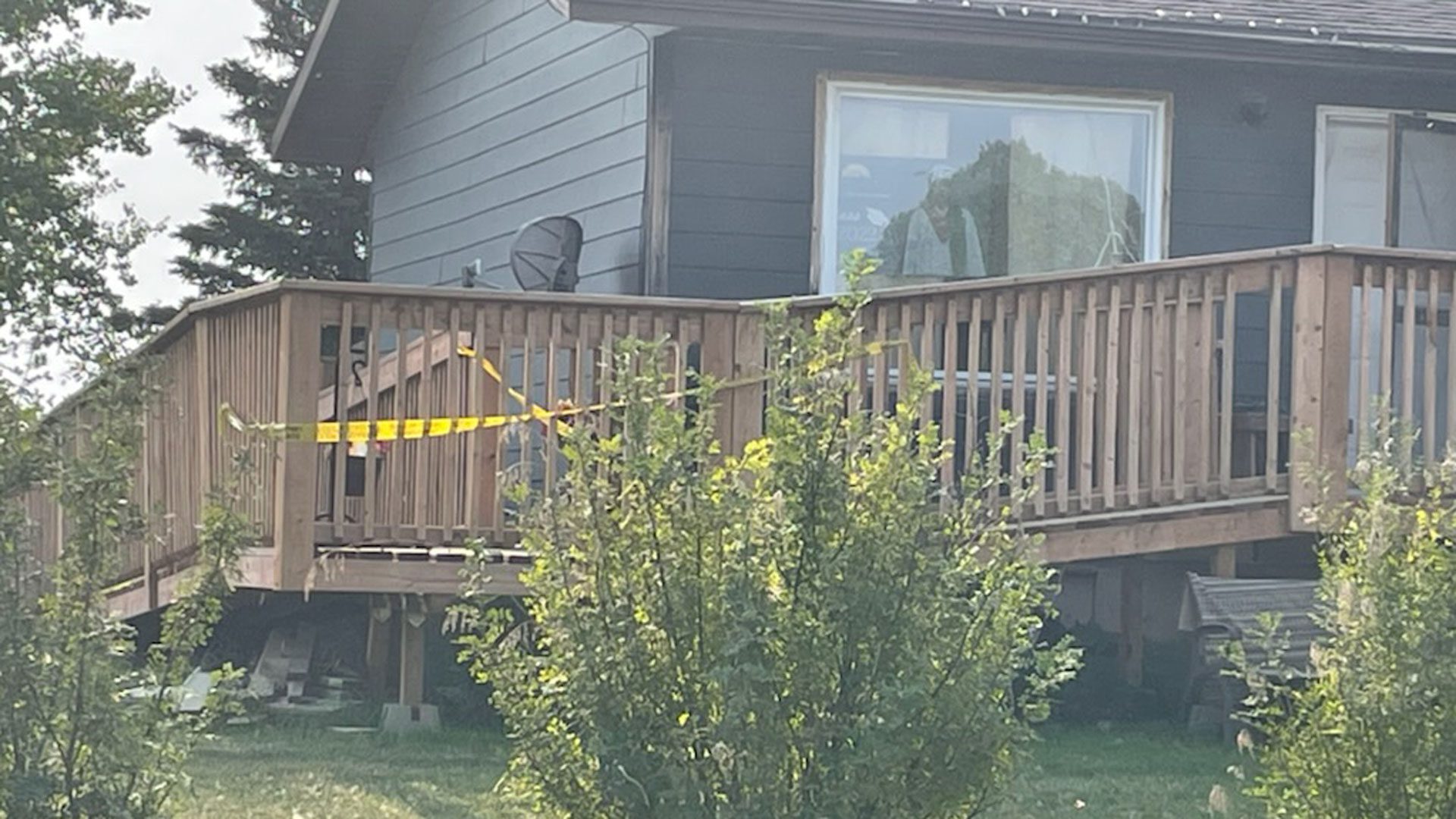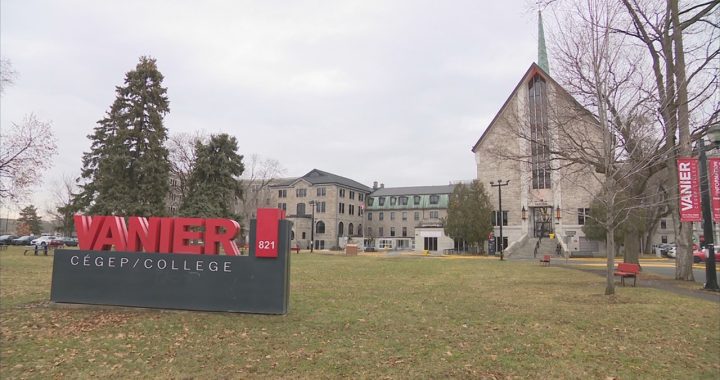
Saskatchewan Public Safety Minister Chrisine Tell, PAGC Grand Chief Bryan Hardlotte and Marco Mendicino, federal public safety minister at the signing ceremony Monday. Photo: Leanne Sanders/APTN.
Calling it a historic agreement, the federal and provincial ministers of Public Safety and the grand chief of the Prince Albert Grand Council (PAGC) signed a “letter of intent” to explore new ways to offer policing in First Nations communities.
The agreement involves 12 First Nations with a total of 28 communities that fall under the umbrella of the PAGC.
Grand Chief Brian Hardlotte said the council has a mandate from all the chiefs to work towards community safety and self-administered policing since 2019.
“We do have immediate challenges in public safety, in community safety. And what is that? We have outdated CTA’s-community tri-partite agreements,” he said.
Listing immediate needs, Hardlotte said updating those agreements is at the top of the list. He said the RCMP does not enforce bylaws voted on at the band level and that also needs to change immediately.
“Your BCRs – your band-councillor resolutions – are they honoured by RCMP? They are not,” he said.
Hardlotte told the gathering that the ministers were the ones with the power to change things. He commended the communities that already have security guards and peacekeepers.
“Your own source funding, right? You take care of them-you provide the money from the limited resources-funding that you get from the federal government,” he said.
“That’s another immediate that we can address.”
Hardlotte also said the lack of RCMP detachments in all communities is something the chiefs can all work on.
Hardlotte also said in spite of declaring policing an essential service, the federal government didn’t come up with the money to make it happen. He said he’s hopeful that with this agreement, and that the “money will begin to flow.”
Hardlotte said he told the ministers in a private meeting earlier in the day that they are all elected people and they all want the same thing and it was time to make it happen.

Wally Burns, chief of James Smith Cree Nation, said today was a good day of dialogue.
His community is trying to heal from a stabbing attack that claimed 11 lives and injured another 18 at the beginning of September.
Myles Sanderson, 32, the suspect in the attacks, died in police custody.
Some have said the death toll wouldn’t have been as high if James Smith had its own police force and more resources.
“Dealing with the trauma with our people, asking them, requesting them how they feel-this morning was very hard. A lot of them broke down. And to me, this shouldn’t have happened to anybody and any nation.”
Burns said his nation has been working on healing and moving forward.
“Losing a brother, sisters, nephews, aunties, uncles, it’s so hard because a lot of it goes back into the community, how are we supposed to cope with all of this?” he said.
Burns said on-reserve policing is needed immediately, to deal with drug dealers coming into the nation.
“The way I see security (guards) right now, that’s just pieces of the iceberg,” he said. “What will they do when they encounter a big mess, drug dealers? Hit them with their flashlight?”
Burns said security and safety have to be pushed in the education system from Grade 1 to Grade 12.
“I don’t want to see this happening to another community – it hurts, it hurts so much. I didn’t even get debriefed because ever since day one when this started, lack of sleep. But faith keeps me going, the hope,” he said.
The head of the Federation of Sovereign Indigenous Nations said the promise that pre-dated the treaties was to have a “red coat” in every community.
When questioned why it has taken so long for the government of Canada to fulfill its promise, Marco Mendocino, the federal minister of Public Safety said that it’s a long and complicated relationship that First Nations have had with Canada and that they are moving ahead now.
“There’s a complex answer that involves resource challenges that we continue to discuss with the RCMP,” Mendocino said.
The minister acknowledged that there’s a long way to go in rebuilding a relationship between the RCMP and First Nations that was damaged by their role in the residential school system.
“In my view, we need to be sure when communities call for help, that they get it no matter where they live, and that’s the whole point of the work today, the letter of intent,” he said.
Setting up a police force isn’t as easy as it sounds.
Read More:
Setting up a tribal police service can be lengthy process says First Nations Chiefs of Police
The executive director of the First Nations Chiefs of Police Association (FNCPA) told APTN News in a September interview that securing money is just one of the many steps in establishing a self-administered tribal police service.
Lennard Busch said even before that, a study must be done to determine the feasibility of starting a service within a particular community or region.
“Since 1991, since being in that (First Nations Police) program, almost a third of self-administered First Nations police services that were started have disbanded or failed. And we’ve learned that for a large part, it was the smaller police services that were running into problems,” said Busch.
“And that’s quite understandable—if you have a small police service say, with four or five police officers, one retires, and one quits and one gets sick, it’s really difficult to deliver the service and then they’re in trouble.”
Mendocino couldn’t give a concrete timeline on how quickly the agreement can be turned into law, or how much funding will be tied to it.










